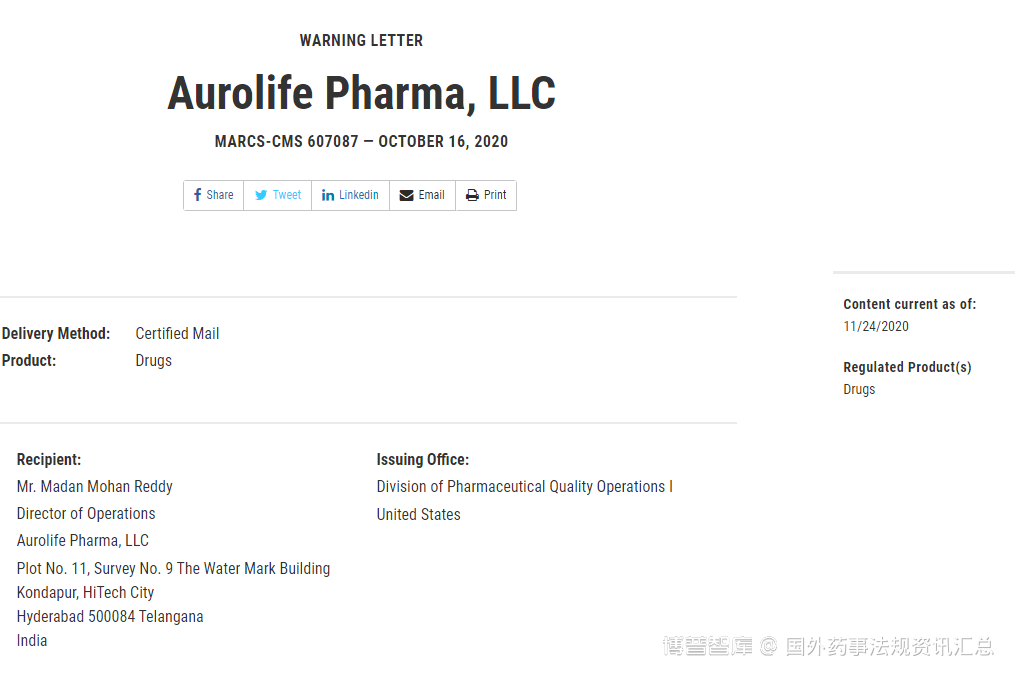FDA警告信原文链接:https://www.fda.gov/inspections-compliance-enforcement-and-criminal-investigations/warning-letters/aurolife-pharma-llc-607087-10162020
FDA于11月24日发布了一篇警告信,针对美国一工厂问题,FDA提出了该工厂不满足cGMP的相关要求。全文翻译如下:

美国食品和药物管理局(FDA)于2020年1月13日至2月12日检查了贵公司位于新泽西州代顿市北130号公路2400号和新泽西州代顿市惠灵路6号的AuroLife Pharma,LLC,FEI 3005796917。
本警告函总结了对成品药现行良好生产规范(CGMP)规定的重大违规行为。参见美国联邦法规(CFR)第21篇,第210和211部分(21 CFR第210和211部分)。
由于贵方制造、加工、包装或保存的方法、设施或控制措施不符合CGMP,贵方的药品属于《联邦食品、药品和化妆品法》(FD&C Act)第501(a)(2)(B)节(《美国法典》第21卷第351(a)(2)(B)节的规定。
我们详细审查了你方2020年3月5日对我方表格FDA 483的回复,并确认收到你方随后的信函。
在我们的检查中,我们的调查人员观察到具体的违规行为,包括但不限于以下内容。
1.贵公司未能彻底调查批次或其中任何组件的任何无法解释的差异或故障,无论批次是否已经分发(21 CFR 211.192),都无法满足其任何规格。
贵公司在没有充分调查确定失败的根本原因的情况下,宣布奥氮平活性药物成分(API)和成品药的初始不合格(OOS)杂质检测结果无效。
例如,在第#56119018批次的奥氮平片剂杂质测试过程中,计算出相对保留时间(RRT)(b)(4)的杂质浓度为0.3%,超出了任何未识别杂质的规范(不超过(b)(4)%)。你没有充分调查这个结果。
在OOS调查期间,您使用原始样本两次确认OOS结果。然后,您测试了来自同一批次的新样本,结果通过,并且只报告了通过的重新测试结果。在没有证据的情况下,你的结论是杂质的结果是由于来自臼齿和杵的污染。
此外,您未能调查用于生产奥氮平片剂的奥氮平原料药的杂质OOS测试结果。例如,六批这种原料药在RRT(b)(4)时超过了一种未知杂质的规范限值(b)(4%)。
你没有充分调查这些杂质测试的失败。你放行了其中5批原料药用于成品药生产,而拒绝了一批。在不合格批次(b)(4)中,您在另一个RRT中发现了一种未知的高杂质。在检查过程中,公司人员表示,这批货物在储存期间经历了高温漂移。
长期以来,您一直无法保证保存该原料药的冷藏库单元的所需温度。
虽然您将(b)(4)RRT的OOS结果归因于HPLC方法问题,包括缺少柱预洗,但您未能及时实施纠正措施。在我们的检查之后,你方至少测试了(b)(4)批,然后对方法进行了修正。
在您的回复中,您写道贵公司将重新评估批次#56119018的OOS结果,并在必要时召回该批次。关于奥氮平原料药,你在信中写道:“质量控制管理层在(b)(4)RRT条件下验证了受试品峰值的所有测试和放行批次”,并确定原料药批次在规范范围内。你还写道,你同意你的OOS调查程序不充分,需要修改。
你的回答不够充分。我们不同意您的结论,即有足够的证据证明五批奥氮平原料药的OOS结果无效。您也没有进行回顾性评估,以确定您的实验室在没有强有力的科学依据和明确证据的情况下宣布OOS结果无效。此外,您修改过的OOS程序仍然不够。例如,当实验室原因无法确定时,它未能确保对潜在制造原因进行彻底调查。
针对本函,请提供:
•在奥氮平原料药批号(b)(4)和(b)(4)中,未知杂质不合格的杂质(规格:NMT(b)(4)%。在确定这些杂质后:
o确定在强制降解研究中是否可能发现这些杂质
o确定哪些根本原因最有可能与所发现的降解剂有关
o扩大对奥氮平原料药其他批次类似RRT中OOS结果的调查,并进行识别和适当的根本原因分析
•审查在与失败批次相同的条件下储存或潜在储存的所有奥氮平原料药批次。
•贵公司收到的每批奥氮平原料药的所有试验结果汇总,无论数据是否无效或批次是否被拒收。每个批次的测试结果应包括生成的每个数据点。
•对您的实验室实践、程序、方法、设备、文件和分析员能力进行全面、独立的评估。在此基础上,提供一个详细的计划,以补救和评估您的实验室系统的有效性。
•对目前在美国市场上且自本函日期起有效期内产品的所有失效OOS(包括过程中和放行/稳定性试验)结果进行回顾性、独立性审查,并提交一份总结分析结果的报告,包括每个OOS的以下内容:
o确定与无效OOS结果相关的科学理由和证据是否确凿地或非决定性地证明了导致实验室错误。
o对于最终确定实验室根本原因的调查,提供基本原理,并确保所有其他易受相同或类似根本原因影响的实验室方法得到识别,以便进行补救。
o对于通过回顾性审查发现的所有OOS结果,在实验室中没有确定的或没有根本原因的,包括对生产的彻底审查(例如,批量生产记录、制造步骤的充分性、设备/设施的适用性、原材料的可变性、工艺能力、偏差历史,投诉历史记录、批次故障历史记录)。为每次调查提供潜在制造根本原因的摘要,以及任何制造操作改进。
•OOS结果调查系统的全面审查和补救计划。纠正措施和预防措施(CAPA)计划应包括但不限于以下内容:
o质量部门监督实验室调查
o确定不良实验室控制趋势
o解决实验室变化的原因
o当无法确定实验室原因时,启动对潜在制造原因的彻底调查
o充分界定每项调查及其CAPA
o修订OOS调查程序以及这些和其他补救措施。
2.您的公司未能使用于制造,加工,包装或保存药品的建筑物保持良好的维修状态(21 CFR 211.58)。
您未能充分维护设备的良好维修状态。
例如,在2018年,密封室天花板(b)(4)发生了四次漏水事件
此外,您的包装区域((b)(4)和(b)(4))至少有五个漏水事件
如果您未能确保设施得到充分维护,可能会对成品药品的质量构成风险,包括对水分敏感的药物吡格列酮HCL片剂。
您的公司无法确保及时解决这些泄漏的根本原因,并且无法充分评估由于产品暴露于高湿度环境而导致的风险。
在您的答复中,我们确认您已承诺召回在FDA 483表中在观察编号1中明确列出的批次。您还写道,您打算添加一项要求以检查CAPA有效性,并开发一种处理生产异常的新程序。您的答复未能解决执行管理人员未能充分认识到这些泄漏带来的风险的原因,并且没有充分解决您将如何确保迅速解决设备维修的问题。
针对此信,请提供:
•您的CAPA计划对设施和设备实施例行的,警惕的运营管理监督。该计划应确保除其他事项外,迅速发现设备/设施性能问题,有效执行维修,遵守适当的预防性维护计划,及时对设备/设施基础设施进行技术升级以及改进系统以进行持续的管理审查。您的计划还应确保在整个公司网络中采取适当的措施。
•回顾性审查可能受到不利影响的药物,包括化学(例如溶出度,降解物)和微生物属性。审查应包括诸如由于泄漏引起的水分含量升高等因素,还应包括对
产生此类信息的所有记录,包括维护,偏差和设施维修的记录。
•在工厂内发生泄漏期间,测试保留制造的对水分敏感的药物样品。
3. 贵公司未能建立和遵守设备清洁和维护的书面程序(21 CFR 211.67(b))。
在检查期间,我们的调查人员观察到了您的工厂内覆盖着粉末的表面,包括原料药取样室、原料分配室、公共生产走廊区域、造粒室和压缩室。
例如,在a(b)(4)制粒室中,我们观察到(b)(4)面板、房间地板和a(b)(4)控制面板表面上有粉末残留物。
在您的工厂的许多区域观察到的可见粉末可能会导致成品交叉污染。值得注意的是,由于生产高效药物产品,这种偏差所造成的危险性会加剧。
在你的答复中,你说你将修改你的清洁程序,并培训你的员工。您的答复未能解决您设施中粉末控制不足的根本原因,并提出适当的纠正建议。
在您回复本函时,请提供:
•您的CAPA计划确保您的设施中有有效的粉末控制(例如排气)系统。
•对您的清洁效果进行全面、独立的回顾性评估,以评估交叉污染危害的范围。包括残留物的标识、可能被不当清洗的其他制造设备以及是否可能已发布交叉污染产品以供分发。评估应确定设施设计、清洁程序或清洁做法中的任何不足之处。它应包括每个生产室和用于制造一个以上产品的制造设备。
4.您的公司未能建立足够的书面生产和过程控制程序,以确保所生产的药品具有其声称或代表拥有的特性,强度,质量和纯度(21 CFR 211.100(a))。
为了减少三种对乙酰氨基酚和磷酸可待因片剂的制造过程时间,您实施了制造过程更改。使用此新过程,您制造了(b)(4)个过程性能鉴定(PPQ)批次。您拒绝(b)(4)个批次的均匀性失败(例如,混合,含量均匀性),并释放了其余(b)(4)个批次。
在释放那些(b)(4)批次之前,您没有数据来支持您的过程处于受控状态。
您对实施后的过程变更的评估得出结论,即新过程导致混合不均匀,您以前的制造过程更加一致且稳定,剩余批次应等待进一步讨论。在此初始评估之后的八个月,您决定恢复到旧流程。但是,您的公司确定可以分发隔离批次。
在答复中,您写道,您将检查这些批次并在必要时召回。
您还写道,只有前(b)(4)个连续的“成功制造”的PPQ验证批次才可以考虑投放市场,而之前任何失败的PPQ批次都可以考虑为“(b)(4)”。如果在PPQ批次中发现任何故障,则添加了原因,“根本原因无法确定,则该故障批次和该故障批次之前制造的批次将不会投放市场。”您的答复不充分,因为在确定您的过程是否处于初始控制状态时,您提出的验证策略无法确保正确评估所有PPQ批次。
我们确认您最近决定撤回使用新流程生产的PPQ批次。
流程验证会评估整个流程生命周期中设计的合理性和流程的控制状态。制造过程中的每个重要阶段都必须进行适当的设计,并确保原材料输入,加工中材料和成品药品的质量。未能进行这些研究可能会导致产品质量属性失败。过程资格研究确定是否已建立初始控制状态。商业发行之前,必须进行成功的过程资格研究。此后,有必要对过程性能和产品质量进行持续的监督,以确保您在整个产品生命周期中保持稳定的制造运营。
请参阅FDA的指导文件“过程验证:一般原则和实践”,以获取FDA认为过程验证的适当元素的一般原则和方法,网址为https://www.fda.gov/media/71021/download
针对此信,请提供:
•有关确保整个产品生命周期内的控制状态的验证程序的详细摘要,以及相关的程序。描述您的程序以进行过程性能鉴定,并持续监控批内和批间变化,以确保持续的控制状态。
•确定每种上市药品的PPQ是否已正确执行并使用了适当的标准。
顾问推荐
根据我们在贵公司发现的违规行为的性质,我们强烈建议聘请符合21 CFR 211.34规定的合格顾问来协助贵公司满足CGMP要求。
您聘请顾问并不能免除公司遵守CGMP的义务。您公司的执行管理层仍然有责任解决所有缺陷和系统缺陷,以确保持续符合CGMP。
结论
本信函中引用的违规行为并非旨在列出您机构中存在的所有违规行为。您有责任调查和确定这些违规的原因,并防止其再次发生或发生其他违规情况。
如果您正在考虑可能会导致您的工厂生产的药物供应中断的行动,则FDA要求您立即联系CDER的药物短缺人员(drugshortages@fda.hhs.gov),以便FDA可以与您以最有效的方式使您的运营符合法律规定。与毒品短缺人员联系还可以使您履行根据21 U.S.C.要求举报药品生产中断或中断的义务。 356C(b)。这也使FDA可以尽快考虑可能需要采取什么措施,以避免短缺和保护依赖您产品的患者的健康。
及时纠正这封信中提到的违规行为。不及时纠正这些违法行为可能会导致采取法律行动,恕不另行通知,包括但不限于扣押和强制令。此警告信中未解决的违反行为也可能阻止其他联邦机构授予合同。
FDA还可能拒绝批准出口证书申请,也不会批准将您的工厂列为供应商或制造商的新药申请或补遗,直到上述违法行为得到纠正。我们可能会重新检查以确认您已完成纠正措施。
收到这封信后,请在15个工作日内以书面形式答复该办公室。指定自我们检查以来您所做的事情,以纠正您的违规行为并防止其再次发生。如果您无法在15个工作日内完成纠正措施,请说明延误原因和完成时间表。
如果您认为您的产品未违反《 FD&C法案》(或您已遵守FDA法规),请提供您的理由和任何支持信息,以供我们考虑。
FDA警告信原文:
October 16, 2020
Dear Mr. Reddy:
The U.S. Food and Drug Administration (FDA) inspected your drug manufacturing facility, AuroLife Pharma, LLC, FEI 3005796917, at 2400 Route 130 North, Dayton, New Jersey, and 6 Wheeling Road, Dayton, New Jersey, from January 13 to February 12, 2020.
This warning letter summarizes significant violations of current good manufacturing practice (CGMP) regulations for finished pharmaceuticals. See Title 21 Code of Federal Regulations (CFR), parts 210 and 211 (21 CFR parts 210 and 211).
Because your methods, facilities, or controls for manufacturing, processing, packing, or holding do not conform to CGMP, your drug products are adulterated within the meaning of section 501(a)(2)(B) of the Federal Food, Drug, and Cosmetic Act (FD&C Act), 21 U.S.C. 351(a)(2)(B).
We reviewed your March 5, 2020, response to our Form FDA 483 in detail and acknowledge receipt of your subsequent correspondence.
During our inspection, our investigators observed specific violations including, but not limited to, the following.
1. Your firm failed to thoroughly investigate any unexplained discrepancy or failure of a batch or any of its components to meet any of its specifications, whether or not the batch has already been distributed (21 CFR 211.192).
Your firm invalidated initial out-of-specification (OOS) impurity testing results for your olanzapine active pharmaceutical ingredient (API) and finished drug product without sufficient investigation to determine the root cause of the failures.
For example, during impurity testing of olanzapine tablets, batch #56119018, an impurity at relative retention time (RRT)(b)(4)(b)(4)
During the OOS investigation, you confirmed the OOS results twice using the original sample. Then you tested a new sample from the same batch with a passing result, and only reported the passing re-test result. Without supporting evidence, you concluded that the impurity results were due to contamination from the mortar and pestle.
Furthermore, you failed to investigate impurity OOS test results for olanzapine API used to make your olanzapine tablets. For example, six lots of this API exceeded the specification limit of(b)(4)(b)(4)
You did not adequately investigate these impurity test failures. You released five of these API lots for finished drug production and rejected one. In the rejected lot,(b)(4)
You had prolonged problems assuring maintenance of the required temperatures of the refrigerated storage unit in which this API was stored.
While you attributed the OOS results at(b)(4)(b)(4)
In your response, you wrote that your firm will re-evaluate the OOS results for batch #56119018 and recall the batch if necessary. Regarding the olanzapine API, you wrote that your “QC management verified all the tested and released lots for the subject peak at(b)(4)
Your response is inadequate. We disagree with your conclusion that there was sufficient evidence to invalidate the OOS results for the five lots of olanzapine API. You also did not perform a retrospective assessment to identify all OOS results that were invalidated by your laboratory without strong scientific justification and clear evidence. Additionally, your revised OOS procedure remains insufficient. For example, it failed to ensure a thorough investigation of potential manufacturing causes is initiated whenever a laboratory cause cannot be conclusively identified.
In response to this letter, provide:
• The identity of the impurities at RRT(b)(4)(b)(4)(b)(4)(b)(4) o Determine if these impurities were potentially seen in forced degradation studies o Expand your investigation of OOS results at similar RRT in other batches of olanzapine API, and perform identification and proper root cause analysis
• A review of all batches of olanzapine API that were stored, or potentially stored, under the same conditions as the failed batch.
• A summary of all test results for each lot of olanzapine API received by your firm, regardless of whether the data was invalidated or if the lot was rejected. Test results for each lot should include each data point generated.
• A comprehensive, independent assessment of your laboratory practices, procedures, methods, equipment, documentation, and analyst competencies. Based on this review, provide a detailed plan to remediate and evaluate the effectiveness of your laboratory system.
• A retrospective, independent review of all invalidated OOS (including in-process and release/stability testing) results for products currently in the U.S. market and within expiry as of the date of this letter and a report summarizing the findings of the analysis, including the following for each OOS: o For investigations that conclusively establish laboratory root cause, provide rationale and ensure that all other laboratory methods vulnerable to the same or similar root cause are identified for remediation.
• A comprehensive review and remediation plan for your OOS result investigation systems. The corrective action and preventive action (CAPA) plan should include but not be limited to addressing the following: o Identification of adverse laboratory control trends o Initiation of thorough investigations of potential manufacturing causes whenever a laboratory cause cannot be conclusively identified o Revised OOS investigation procedures with these and other remediations.
2. Your firm failed to maintain buildings used in the manufacture, processing, packing or holding of drug products in a good state of repair (21 CFR 211.58).
You failed to adequately maintain your facility in a good state of repair.
For example, in 2018, you had four incidences of water leakage from the ceiling of your encapsulation room(b)(4)
In addition, there were at least five instances of water leaks in your packaging area (rooms(b)(4)(b)(4)
Your failure to ensure that your facility is adequately maintained may pose a risk to the quality of your finished drug products, including the moisture sensitive drug, pioglitazone HCL tablets.
Your firm failed to ensure that the root cause of these leaks was addressed promptly and to adequately assess the risks due to exposure of products to elevated ambient moisture.
In your response, we acknowledge you have committed to recalling the batches that were specifically listed on the Form FDA 483 in Observation #1. You also wrote that you plan to add a requirement to examine CAPA effectiveness and develop a new procedure for handling production anomalies. Your response failed to address why your executive management failed to fully recognize the risks from these leaks, and adequately address how you will ensure that facility repairs are addressed promptly.
In response to this letter, provide:
• Your CAPA plan to implement routine, vigilant operations management oversight of facilities and equipment. This plan should ensure, among other things, prompt detection of equipment/facilities performance issues, effective execution of repairs, adherence to appropriate preventive maintenance schedules, timely technological upgrades to the equipment/facility infrastructure, and improved systems for ongoing management review. Your plan should also ensure that appropriate actions are taken throughout the company network.
• A retrospective review of drugs that may have been negatively impacted, including both chemical (e.g., dissolution, degradants) and microbiological attributes. The review should include factors such as elevated moisture levels due to leaks, and also include assessment of
• Test retain samples of moisture sensitive drugs manufactured during periods that leakage occurred in your facilities.
3. Your firm failed to establish and follow written procedures for cleaning and maintenance of equipment (21 CFR 211.67(b)).
During the inspection, our investigators observed surfaces covered in powder throughout your facility including API sampling rooms, raw material dispensing rooms, common production corridor areas, granulation rooms, and compression rooms.
For example, in a(b)(4)(b)(4)(b)(4)
The visible powder observed in numerous areas of your facility could lead to cross-contamination of your finished drug products. Notably, the hazard posed by this deviation is heightened because you manufacture high potency drug products.
In your response, you stated you will revise your cleaning procedures and train your personnel. Your response failed to address the root cause of inadequate powder control in your facility and propose adequate corrections.
In your response to this letter, provide:
• Your CAPA plan to ensure that you have effective powder control (e.g., exhaust) systems in your facility.
• A comprehensive, independent retrospective assessment of your cleaning effectiveness to evaluate the scope of cross-contamination hazards. Include the identity of residues, other manufacturing equipment that may have been improperly cleaned, and an assessment whether cross-contaminated products may have been released for distribution. The assessment should identify any inadequacies in facility design, cleaning procedures, or cleaning practices. It should encompass each production room and piece of manufacturing equipment used to manufacture more than one product.
4. Your firm failed to establish adequate written procedures for production and process control designed to assure that the drug products you manufacture have the identity, strength, quality, and purity they purport or are represented to possess (21 CFR 211.100(a)).
To reduce the manufacturing process time for three strengths of acetaminophen and codeine phosphate tablets, you implemented a manufacturing process change. Using this new process, you manufactured(b)(4)(b)(4)(b)(4)
You did not have data to support that your process was in a state of control prior to releasing those(b)(4)
Your evaluation of the process change after implementation concluded that the new process resulted in a non-uniform blend, your previous manufacturing process was more consistent and robust, and the remaining batches should be held pending further discussion. Eight months after this initial evaluation you made the decision to revert to the old process. However, your firm determined that the quarantined batches could be distributed.
In your response, you wrote that you would review these lots and recall if necessary.
You also wrote that only the first(b)(4)(b)(4)
We acknowledge you have recently made the decision to recall the PPQ batches made using the new process.
Process validation evaluates the soundness of design and state of control of a process throughout its lifecycle. Each significant stage of a manufacturing process must be designed appropriately and ensure the quality of raw material inputs, in-process materials, and finished drugs. Failure to conduct these studies can result in product quality attribute failures. Process qualification studies determine whether an initial state of control has been established. Successful process qualification studies are necessary before commercial distribution. Thereafter, ongoing vigilant oversight of process performance and product quality is necessary to ensure you maintain a stable manufacturing operation throughout the product lifecycle.
See FDA’s guidance documentProcess Validation: General Principles and Practicesfor general principles and approaches that FDA considers appropriate elements of process validation at https://www.fda.gov/media/71021/download.
In response to this letter, provide:
• A detailed summary of your validation program for ensuring a state of control throughout the product lifecycle, along with associated procedures. Describe your program for process performance qualification, and ongoing monitoring of both intra-batch and inter-batch variation to ensure a continuing state of control.
• A determination of whether the PPQ for each of your marketed drug products was properly executed and used the appropriate criteria.
Consultant recommended
Based upon the nature of the violations we identified at your firm, we strongly recommend engaging a consultant qualified as set forth in 21 CFR 211.34 to assist your firm in meeting CGMP requirements.
Your use of a consultant does not relieve your firm’s obligation to comply with CGMP. Your firm’s executive management remains responsible for resolving all deficiencies and systemic flaws to ensure ongoing CGMP compliance.
Conclusion
The violations cited in this letter are not intended to be an all-inclusive list of violations that exist at your facility. You are responsible for investigating and determining the causes of these violations and for preventing their recurrence or the occurrence of other violations.
If you are considering an action that is likely to lead to a disruption in the supply of drugs produced at your facility, FDA requests that you contact CDER’s Drug Shortages Staff immediately, at drugshortages@fda.hhs.gov, so that FDA can work with you on the most effective way to bring your operations into compliance with the law. Contacting the Drug Shortages Staff also allows you to meet any obligations you may have to report discontinuances or interruptions in your drug manufacture under 21 U.S.C. 356C(b). This also allows FDA to consider, as soon as possible, what actions, if any, may be needed to avoid shortages and protect the health of patients who depend on your products.
Correct the violations cited in this letter promptly. Failure to promptly correct these violations may result in legal action without further notice including, without limitation, seizure and injunction. Unresolved violations in this warning letter may also prevent other Federal agencies from awarding contracts.
FDA may also withhold approval of requests for export certificates and approval of pending new drug applications or supplements listing your facility as a supplier or manufacturer until the above violations are corrected. We may re-inspect to verify that you have completed your corrective actions.
After you receive this letter, respond to this office in writing within 15 working days. Specify what you have done since our inspection to correct your violations and to prevent their recurrence. If you cannot complete corrective actions within 15 working days, state your reasons for delay and your schedule for completion.
If you believe that your products are not in violation of the FD&C Act (or you have complied with FDA regulations), include your reasoning and any supporting information for our consideration.
Please send your electronic reply to Yvette Johnson, Compliance Officer at ORAPHARM1_RESPONSES@fda.hhs.gov and CDER-OC-OMQ-Communications@fda.hhs.gov. Please identify your response with FEI 3005796917.

